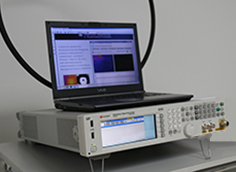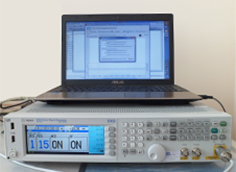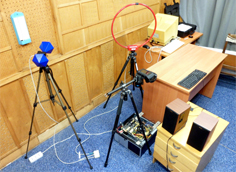DETECTOR - TESTING COMPLEX OF COMPUTING EQUIPMENT FOR THE PRESENCE OF DEVICES OF UNAUTHORISED OPPORTUNITIES
|
|
|
|
PURPOSE
The detector is used for testing computing equipment, which processes confidential information, for the presence of devices of unauthorized opportunities: radio receiving devices in frequency range from 10 to 3000 MHz, radio transmitting devices and equipment for collecting acoustic information.
The detector includes a tract of provoking electromagnetic and acoustic signals, a measuring tract and control computer.
TECHNICAL CHARACTERISTICS
The tract of provoking electromagnetic signals includes:
- a generator of provoking electromagnetic signals (10...3000 ÌHz)
- an adaptor
- an antennae for generator set
Types of electromagnetic signals:
- with amplitude modulation
- with frequency modulation
- with phase modulation
- with quadrature modulation
- with amplitude impulse modulation by single impulses with big duty cycles (more than 100)
- with quadrature modulation with bit depth of 32
- IRIDIUM signal in the frequency range of 1616,0...1626,5 ÌHz with QPSK manipulation
- GSM signal in the frequency range of 935...960 ÌHz, 1805...1880 ÌHz with MSK manipulation
- UMTS (3G) signal in the frequency range of 2110...2170 ÌHz with QPSK and 16QAM manipulation
- CDMA signal in the frequency range of 460...470 ÌHz with FM4 phase manipulation
- Bluetooth signal in the frequency range of 2,402...2,48 GHz with FSK manipulation
- Wi-Fi signal in the frequency range of 2,402...2,48 GHz with BPSK, QPSK, QAM manipulation (software complex «Basic 802.11a/b/g/j/p WLAN»)
| Mode of smooth frequency tuning | manual |
| Input signal frequency range of the adaptor, ÌHz | 10...3000 |
| Output signal frequency range of the passive frame antenna, ÌHz | 10...30 |
| Output signal frequency range of the passive biconical antenna, ÌHz | 30...3000 |
The tract of provoking acoustic signals includes:
- a set of acoustic transformers
- software which generates acoustic signals
Types of acoustic signals:
- harmonic signals
- speech-like successions
| Frequency range of harmonic signals, Hz | 100...8000 |
| Range of automatic frequency scan, Hz | 100...8000 |
| Frequency range of speech-like successions, Hz | 180...5600 |
| Acoustic signals in the range of 100...8000 Hz with the level of noise pressure, dB, no less than | 70 |
The measuring tract includes a thermal camera. The tract is used for detecting temperature changes of the object under testing in time.
| Definition in the range of 8...14 µm, Ñ, not worse than | 0,04 |
| Matrix, px | 640x480 |
The control computer is used for controlling the generator of electromagnetic signals, signal formation for acoustic transformers, analysis and processing of images received through the thermal camera and reporting on the results of testing.
| Cash memory of processor, Mb | 3 |
| Processor frequency, MHz | 2600 |
| RAM, Mb | 4096 |
OPERATIONAL PRINCIPLE
1. Peculiarities of the testing procedure for the presence of devices of unauthorized opportunities:
- The testing shall be conducted in test mode with the aim to exclude the influence of environment on the changes of allocation of thermal fields on the tested units and modules of computing equipment.
- Before the test, accumulation and averaging of allocation of thermal fields shall be done across the object which is being tested, as well as static characteristics of allocation shall be measured. Threshold values are given to the deviation of thermal field from the basic value of the given field of the object. When the current allocation of the thermal field of the object exceeds the threshold value, it is considered to be an anomaly, which is mentioned in the test results with given modes, under which the anomaly was detected.
- Each detected anomaly is analysed and, if necessary, is tested again under those modes under which it was detected, in order to make a decision about the presence of devices of unauthorised opportunities. The complex enables to control the settings change as well as to set up initial parameter values of a PC sound card.
2. Detection of radio receiving devices:
- Testing is based on the fixation of the increase of the radio receiver’s temperature by the thermal camera and control computer.
- A provoking electromagnetic signal is received by the input cascade of the radio receiver and is increased to the level necessary for further processing. The signal increase leads to the temperature increase of the radio receiver components.
- The test duration for each type of the input signal in the range of 10…3000 MHz is 96 min.
3. Detection of radio transmitting devices:
- Testing is based on the fixation of the increase of the temperature of the radio-transmitting output cascade by the thermal camera and control computer.
- Built-in transmitters of unauthorized opportunities can be active during a certain period of time. This is why it is viable not to interrupt the testing when changing provoking influences. Tesing under any provoking influences takes no more than 24 hours.
4. Detection of devices for collecting acoustic information:
- Testing is based on the control of thermal parameters of the components under provoking acoustic influences.
DEVELOPER
R&D LAB 5.3 «Materials and components of electronics and superconducting equipment»
CONTACTS
6, P.Brovki, 220013, Minsk, Republic of Belarus
☏ +375 17 293 89 39
🖷 +375 17 293 89 39
🖂 nil53@bsuir.edu.by
OTHER INNOVATIONS IN THIS AREA
Speech information security device «Priboi»
Speech information security device «Priboi-R»
Electromagnetic-pulse protection device «Impulse-N»
Indoor voice data protection suit «Echo»
Locator for detecting devices of unauthorized information collection


